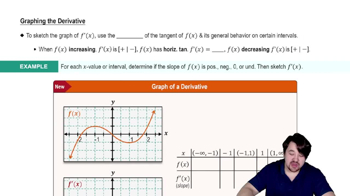Identify the amplitude and period of the following functions.
Table of contents
- 0. Functions7h 54m
- Introduction to Functions16m
- Piecewise Functions10m
- Properties of Functions9m
- Common Functions1h 8m
- Transformations5m
- Combining Functions27m
- Exponent rules32m
- Exponential Functions28m
- Logarithmic Functions24m
- Properties of Logarithms36m
- Exponential & Logarithmic Equations35m
- Introduction to Trigonometric Functions38m
- Graphs of Trigonometric Functions44m
- Trigonometric Identities47m
- Inverse Trigonometric Functions48m
- 1. Limits and Continuity2h 2m
- 2. Intro to Derivatives1h 33m
- 3. Techniques of Differentiation3h 18m
- 4. Applications of Derivatives2h 38m
- 5. Graphical Applications of Derivatives6h 2m
- 6. Derivatives of Inverse, Exponential, & Logarithmic Functions2h 37m
- 7. Antiderivatives & Indefinite Integrals1h 26m
- 8. Definite Integrals4h 44m
- 9. Graphical Applications of Integrals2h 27m
- 10. Physics Applications of Integrals 3h 16m
- 11. Integrals of Inverse, Exponential, & Logarithmic Functions2h 31m
- 12. Techniques of Integration7h 41m
- 13. Intro to Differential Equations2h 55m
- 14. Sequences & Series5h 36m
- 15. Power Series2h 19m
- 16. Parametric Equations & Polar Coordinates7h 58m
0. Functions
Graphs of Trigonometric Functions
Problem 66
Textbook Question
Find a trigonometric function f represented by the graph in the figure. <IMAGE>
 Verified step by step guidance
Verified step by step guidance1
Identify the key features of the trigonometric graph, such as amplitude, period, phase shift, and vertical shift. These features will help determine the specific trigonometric function.
Determine the amplitude by measuring the vertical distance from the midline of the graph to a peak or trough. The amplitude is the absolute value of this distance.
Calculate the period of the function by identifying the horizontal length of one complete cycle of the graph. This can be done by measuring the distance between two consecutive peaks or troughs.
Check for any phase shift by observing if the graph is shifted horizontally from the standard position of a basic trigonometric function like sine or cosine.
Look for any vertical shift by determining if the midline of the graph is above or below the x-axis. This will indicate if the function has been shifted up or down.
 Verified video answer for a similar problem:
Verified video answer for a similar problem:This video solution was recommended by our tutors as helpful for the problem above
Video duration:
7mPlay a video:
Was this helpful?
Key Concepts
Here are the essential concepts you must grasp in order to answer the question correctly.
Trigonometric Functions
Trigonometric functions, such as sine, cosine, and tangent, relate angles to the ratios of sides in right triangles. They are periodic functions, meaning they repeat their values in regular intervals, which is crucial for analyzing wave-like behaviors in graphs. Understanding these functions is essential for interpreting the graph and identifying the specific function that matches its shape.
Recommended video:

Introduction to Trigonometric Functions
Graph Interpretation
Graph interpretation involves analyzing the visual representation of a function to extract information about its behavior, such as amplitude, period, and phase shift. For trigonometric functions, recognizing key features like peaks, troughs, and intercepts helps in determining the specific function that corresponds to the graph. This skill is vital for solving problems that require matching a function to its graphical representation.
Recommended video:

Graphing The Derivative
Function Representation
Function representation refers to expressing a mathematical relationship in various forms, such as equations, graphs, or tables. In the context of trigonometric functions, this includes writing the function in standard form, which may involve parameters like amplitude and frequency. Understanding how to convert between these representations is crucial for accurately identifying the function depicted in the graph.
Recommended video:

Properties of Functions

 5:53m
5:53mWatch next
Master Graph of Sine and Cosine Function with a bite sized video explanation from Patrick
Start learningRelated Videos
Related Practice
Textbook Question
